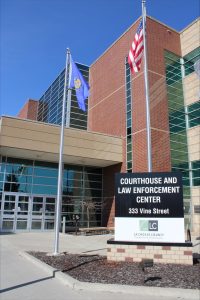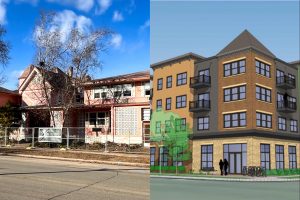WGSS student creates website about sexual misconduct resources on and off campus for capstone
Kayleigh Marshall presenting her WGSS capstone project to peers. Photo retrieved from WGSS department.
December 14, 2019
According to a statement given earlier this year to The Racquet Press by the University of Wisconsin-La Crosse Violence Prevention Specialist Ingrid Peterson, UWL sees between 100 and 125 sexual misconduct cases every academic year, despite statistics indicating much higher rates of violence. In this same interview, Peterson noted that reporting hard statistics of assault is difficult because the act of reporting itself is disorganized.
“It’s difficult to talk about numbers and statistics because they can mean a lot of different things. People always talk about reporting rates, well what do you mean by reporting? To the police? To me? To their roommate?” said Peterson
This year, Women’s, Gender and Sexuality Studies (WGSS) student Kayleigh Marshall decided to undertake the creation of a website for her capstone project, one designed to organize the various sexual misconduct resources on campus.
“We were supposed to choose something substantial and there was a lot of sexual misconduct issues going on. I realized that all of the information about sexual misconduct, and what do, was spread out between several different sources. So I wanted to compile everything into one resource: on-campus resources, off-campus resources, everything you might need into one location,” said Marshall.
Through research, she compiled the information and resources that UWL students found most pertinent to the issue. “I also did a survey as part of my research, and asked around 200 students, like what sorts of information they would want on there, and how they feel about reporting to campus resources. And that helped educate what went on the website,” said Marshall.
In doing so, Marshall created a homepage for several related organizations around La Crosse, while shaping the site’s rhetoric towards the process of wellness rather than arriving at a physical healthy destination.
“Surviving an incident of sexual misconduct, harassment, or assault can be a traumatic experience. It’s just as important for survivors to take care of their mental health as it is to take care of physical health,” is written on the portion of the website dedicated to mental health. The site combines both physiological and psychological health resources by providing locations and contact information to medical professionals who specialize in both.
Marshall said she was frustrated by the lack of education surrounding post-sexual violence procedures, and as a result, was inspired to incorporate both the resources themselves as well as an explanation of what a survivor’s expectations should be. The website also includes explanations of sexual assault forensic exams, commonly known as rape kits.
“I was listening to a podcast that featured a SANE (Sexual Assault Nurse Examiners) nurse in it, and she explained the process of getting a rape kit, and I thought that if I hadn’t listened to this random podcast, I would never know this. So I thought this is something that most people might not and should know,” said Marshall.
The website outlines both the positive outcomes of going through a sexual assault forensic exam, such as its ability to identify any contaminations or impairments to assaulted areas, as well as its ability to provide evidence against a perpetrator, as well as its invasive and intimidating nature. A portion from the website reads, “Getting a rape kit done can be intimidating and scary if someone doesn’t know what to expect. This section lays out exactly what happens during a rape kit so survivors can be prepared.”
The website also includes links to planned parenthood, information and resources on emergency contraception, and a section about sexually transmitted diseases.
Marshall said that by only providing necessary information she was able to maintain the websites neutrality so that survivors would not feel compelled to act a certain way. “There’s a section on there about reporting and why someone might choose to report, and why someone might choose not to report. And sections with both on-campus and off-campus resources so students can make the choice,” said Marshall.
The website is not directly affiliated with the university administration, so it will not be on the UWL homepage. “But after I was finished with it I sent it off to a bunch of different resources on campus; offices and departments on campus that someone might turn to if they needed help. I’m working with them to integrate the information on my website into the UWL site. I’ve met with Ingrid Peterson and Greg Phlegar, [Title IX team] and they want to take parts of my website and integrate them into UWL’s website and then credit me for them. So the site itself won’t be there, but the information from the site will be.”
Marshall mentioned that she has been in contact with the WGSS department, university police, the counseling and testing center, the student health center, the student life office, and the violence and prevention office, and is waiting to see how they will utilize the site in their organizations to benefit students.
Marshall said the feedback from the website has been positive. After presenting on the topic for her capstone she received constructive interest. “The questions people have been really receptive, everyone’s been really interested in the project and wanting to help me advance it forward,” said Marshall. “I was kind of expecting pushback since it’s such a sensitive topic, and there’s been so much debate over it, but everyone that I have contacted and reached out to has been super interested in helping me promote it. That’s the feedback I got at the presentation too. People were giving me different ideas of what I could add to it in the future.”
Marshall said her main goal is to unite student survivors with aid as effectively and objectively as possible. By providing the information to students in this format, a platform for rehabilitation is created, without any subjugation from outside sources.
“Sexual misconduct, or harassment, or assault are all acts that take a lot of control and autonomy away from the survivor,” said Marshall. “So I made this website as a way for survivors to gain some of that control back and have as much information as possible so they could make educated decisions.”







